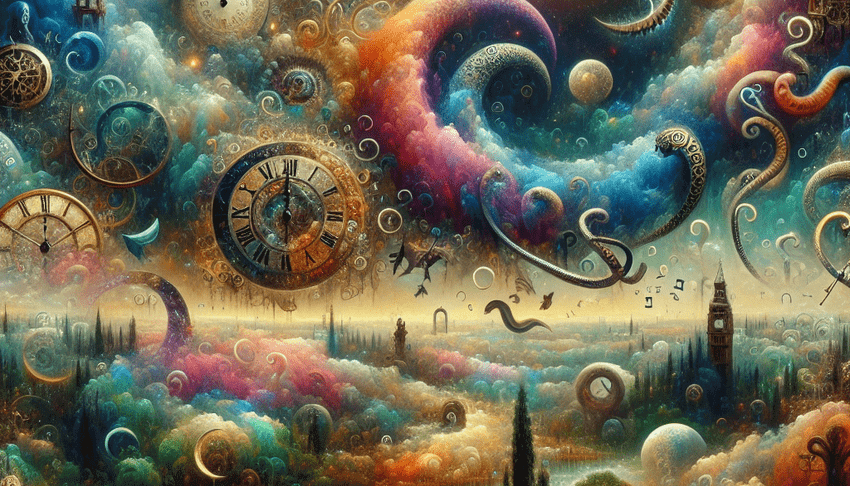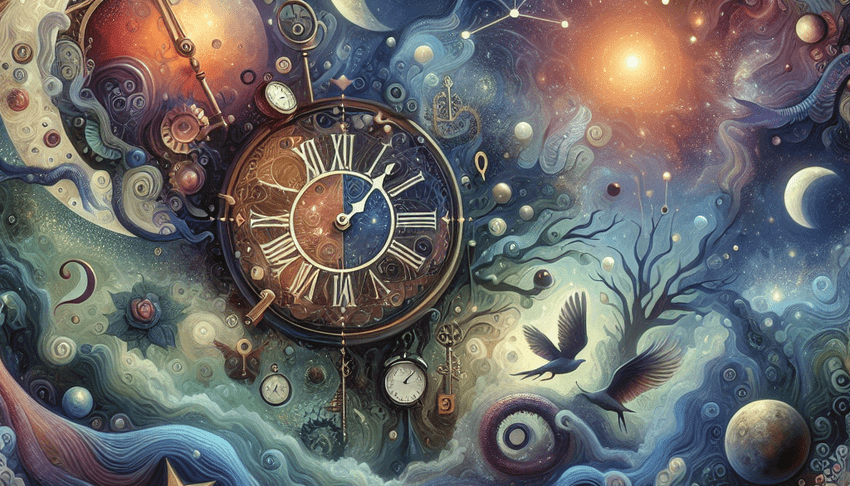Table of Contents
The Evolving Tapestry of Dream Interpretation

Ancient Wisdom – A Dive into Historical Dream Analysis
Dream interpretation and symbolism have mesmerized human minds since the earliest of civilizations, with historical periods illuminating various attitudes and beliefs towards the enigmatic world of dreams. Cultural dream interpretation, in particular, offers a vivid tableau of how ancient societies perceived the nocturnal visions that visited them.
In exploring the historical spectrum of dream analysis, one cannot overlook the profound significance dreams carried in ancient Egypt. It was a culture that revered dreams as portals to the divine, often recording them meticulously. The Egyptian “Dream Book,” for instance, is a testament to the importance they placed on interpreting dreams. This papyrus scroll listed various dreams and their supposed outcomes, offering guidance to the dreamer. Modern scholars studying this artifact have uncovered a treasure trove of symbolism that resonates even in today’s dream interpretations.
Historical Dream Analysis in Mesopotamia
Similarly, Mesopotamia, with its rich mythological tapestry, saw dreams as messages from the gods to be deciphered by priest-diviners. These spiritual intermediaries would interpret dreams to guide kings and laypeople alike, often affecting major decisions. Consider the epic of Gilgamesh, where dream sequences form critical junctions in the hero’s journey. The dreams are symbolic, filled with metaphors about life, death, and destiny, showcasing dream interpretation’s importance in guiding one’s actions and understanding of the world.
- Cultural dream interpretation shaped by divine communications
- The role of priest-diviners in elucidating dream messages
- Epic narratives as a reflection of dreams’ role in ancient wisdom
Turning to the practical application of historical dream analysis, one realizes the continuity and evolution of dream symbolism through time. In both Egypt and Mesopotamia, symbols such as water, animals, and celestial bodies often recurred with specific meanings. Water, for instance, could symbolize the unknown, a journey, or a change in life. These motifs remain prevalent in modern interpretations, forming a bridge between ancient wisdom and contemporary psychological understanding.
Modern dream interpretation still looks to the stories and symbols of the past, finding relevance and insight in the ancient practices. As we decode the symbolism of our own dreams, we connect with a timeless human endeavor to understand our subconscious landscapes. Such cultural dream interpretation enhances our comprehension of historical periods, enriching our perspective on the human experience across millennia.
In conclusion, the legacy of dream symbolism through time is not just a scholarly curiosity but a living dialogue between past and present, dreams and waking life. The enduring relevance of ancient dream analysis reminds us that, despite the passage of centuries, the quest for understanding our dreams remains an integral part of the human journey.
Cross-Cultural Commonalities and Divergences
Dream interpretation is embedded in the fabric of human history and the tapestry of our psyche, offering a fascinating window into the collective and personal subconscious. Cultural dream interpretation has evolved throughout historical periods, yielding a rich diversity of perspectives and practices. Moreover, dream symbolism through time reveals the dynamic relationship between our inner worlds and the external environment across various cultures.
Cultural Dream Interpretation: A Global Tapestry
The quest to comprehend the elusive nature of dreams unites humanity across the globe. Different cultures have developed distinct approaches to interpreting dreams, each reflecting its particular ethos and worldviews. In Ancient Egypt, dreams were seen as prophetic and were often recorded and interpreted with religious fervor. Conversely, in Greek and Roman societies, dreams were categorized, and manuals such as Artemidorus’s “Oneirocritica” showcased an organized system of symbolism that offered individual guidance.
The interest in cultural dream interpretation isn’t a relic of ancient times. Native American traditions, for instance, view dreams as a channel to communicate with the spiritual world, offering guidance and wisdom. Similarly, Aboriginal cultures of Australia regard dreams as a vital aspect of their belief system, referred to as the ‘Dreamtime,’ connecting them to their ancestors and the land.
In contrast, Western approaches, heavily influenced by the works of Sigmund Freud and Carl Jung, dig into the psychological layers of dreams. Freud emphasized the role of the unconscious and repressed desires in dreams, while Jung introduced the concepts of archetypes and the collective unconscious — ideas that resonate with dream symbolism through time.
Patterns of Dream Symbolism
Dream interpretation, despite its cultural nuances, seems to converge on certain universal symbols and motifs. Water, for instance, is often associated with emotion and the subconscious; snakes can symbolize transformation or threat, and flying often represents a desire for freedom or escape.
These motifs resonate within all of us, appearing in dream dictionaries that attempt to provide a common language for our night-time narratives. However, the context of these symbols can vary greatly depending on cultural background. A snake might be seen as a positive symbol of health and renewal in Eastern cultures due to its association with medicinal qualities and the shedding of its skin, contrasting with Western associations of danger or deceit.
The Intersection of Culture and Individual Experience
While cultural interpretations provide a cohesive framework, individual dream analysis is nuanced and personalized. Dreams can be the psyche’s way of processing daily experiences, integrating lessons, or surfacing hidden emotions. Cultural beliefs and values certainly shape dream interpretation, but the individual’s unique life context and experiences add layers of meaning to each dream.
For practitioners and hobbyists alike, the interpretation of dreams is an ongoing exploration of both individual psyche and cultural insights. The universality and diversity of dreams highlight a shared human experience while respecting the rich tapestry of cultural identity and personal symbolism that shapes our understanding of the enigmatic dream world.
For those intrigued by the mosaic of dream interpretation, the journey is never-ending. Through the weaving together of cultural dream interpretation, historical periods, and personal meaning, we continue to explore the depths of our subconscious and the tapestry of human experience that dream symbolism through time so beautifully unveils.
The Cultural Mosaic of Dream Interpretation

Indigenous Insights – Dreams in Tribal Cultures
Dreams have been a cornerstone of human experience throughout history, and their interpretation occupies a special place within the context of many indigenous cultures. The lens through which dreams are viewed and analyzed can significantly affect our understanding of their symbolism and influence. From Native American tribes to Aboriginal Australian communities and Amazonian societies, dreams are not merely nocturnal narratives but pathways to spiritual insight, guides for communal living, and instruments for personal transformation.
Cultural dream interpretation among indigenous peoples
- In Native American societies, dreams are often seen as messages from the spirit world, imparting wisdom or offering guidance. For example, the Lakota people practice hanblecheyapi, also known as “crying for a vision,” where dreams received during a spiritual quest can determine an individual’s life purpose.
- In Aboriginal Australian culture, the ‘Dreamtime’ is a revered era in which ancestral spirits created the world. Here, dreams are not separate from reality but part of a continuum, connecting the past, present, and future, and often guiding community decisions.
- Amazonian tribes, such as the Achuar, participate in dream-sharing rituals each morning. By discussing the visions of the night, they believe dreams hold counsel for the tribe’s actions, influencing hunting expeditions and interpersonal relationships.
Throughout historical periods, dream symbolism has evolved yet retains a deep-seated role in shaping the spiritual and social landscapes of these communities. By offering insights into the connection between personal dreams and collective experiences, these cultures stress the inseparable link between individual wellbeing and the health of the community.
Dream symbolism through time
While in modern times, the psychological interpretation of dreams tends to focus on individual unconscious motivations, indigenous perspectives frequently place a stronger emphasis on the communal implications of dreaming. Such an approach underlines the holistic worldview that many tribal cultures embody, one where every dream is a stitch in the fabric of a larger tapestry encompassing tribe, environment, and cosmos.
In today’s fast-paced, often fragmented world, ancient indigenous wisdom regarding dreams and their interpretations invite us to consider a broader spectrum of existential meaning and interconnectedness. By exploring the cultural dream interpretation and deep-rooted symbolism embraced by indigenous peoples, we invite a greater appreciation for diversity in our quest to understand the rich tapestry of human consciousness across different landscapes and epochs. This not only enriches our perspective on the mysteries of dream interpretation but also encourages respect for the multitude of ways humans find meaning within the nocturnal narratives of their lives.
East Meets West – A Comparative Analysis of Dream Symbolism
Dreams have always been the subject of intrigue and mystery, prompting thinkers and researchers from various historical periods to dive into the depths of the subconscious. Cultural dream interpretation has morphed and developed through time, giving us a rich tapestry of understanding that ranges from the ancient civilizations to modern psychology. And in today’s global village, a comparative analysis between Eastern and Western approaches to dream symbolism can offer fascinating insights into the collective human psyche.
Cultural Influences on Dream Symbolism
In the East, dreams have been significant in spiritual and philosophical contexts. China, with its long history of dream analysis, has traditional dream manuals that categorize dreams into auspicious and inauspicious events. These texts, emerging from the deep roots of Confucianism and Taoism, often ascribe symbolic meanings to elements within dreams that reflect one’s fate or fortune.
Similarly, in India, dream interpretation is linked to vedic texts, where dreams are considered to be indications of inner desires, past lives, or even prophetic messages from the divine. Throughout these Eastern cultures, dreams are seen as integral to understanding one’s self and universe.
Contrasting this, in the West, the psychoanalytic approaches of Freud and Jung place a heavy emphasis on dreams as windows to the unconscious. Freud’s analysis sees dreams as fulfillments of repressed desires, while Jung’s interpretation goes beyond the personal to include what he coined as the collective unconscious – encapsulating the shared experiences and archetypes common to all humans.
- Cultural dream interpretation, from the I Ching to Freud’s ‘The Interpretation of Dreams’, showcases an evolution of thought on what dreams signify.
- Dream symbolism has been interpreted through various lenses from spiritual, philosophical to psychological, influenced by societal norms and beliefs.
- Dreams serve multiple functions, from prognostic tools in ancient cultures to therapeutic instruments in modern psychoanalysis.
Examples and Methodologies
Consider the symbol of water in dreams. In Chinese dream interpretation, water is often symbolic of wealth and abundance, but also, depending on the state of the water, potential danger. In Indian tradition, water could symbolize purification or emotional upheaval. But when we look towards Freudian analysis, water may be a manifestation of bottled-up emotions or desires, whereas Jung might suggest it aligns with universal archetypes relating to the concept of rebirth or the feminine.
In understanding dream interpretation across cultures, it’s essential to consider methodologies. Eastern traditions may involve consulting texts or spiritual leaders, whereas Western psychoanalysis typically involves dialogue between analyst and patient, unpacking the symbolism in the context of individual life experiences and societal norms.
Across the cultural divide, historical periods and shifts in philosophical thought have spawned diverse dream symbolism interpretations through time. For instance, where Eastern approaches may view a snake in a dream as a symbol of wisdom or healing, Western traditions, influenced by Biblical narratives, often associate snakes with temptation or deceit.
The art of dream interpretation exemplifies how culture, history, and individual perspectives intertwine. By comparing Eastern and Western traditions, we not only highlight the diversity of human thought but also the universal quest to understand the enigma posed by our dreams. This comparative analysis opens a window not only into our sleeping minds but into the cultural lenses through which we interpret the world around us. Whether we lean on the ancient manuals of China, the vedic wisdom of India, or the psychoanalytic theories from the West, it is clear that dreams continue to be an essential key to unlocking the depths of human experience and Emotional Intelligence.
Summary
Interpreting dreams has long fascinated civilizations, evolving from divine communication to a reflection of our subconscious. This exploration into the symbolism of dreams reveals a continuous thread from ancient to modern times. Ancient Egyptians considered dreams to be messages from the gods, meticulously documented in the Egyptian “Dream Book.” These interpretations included symbols such as water and animals, which remain prominent in dream analysis today.
Historical Dream Analysis in Mesopotamia
The Mesopotamians also saw dreams as divine messages. Priest-diviners played crucial roles in interpreting these dreams for guidance, as evidenced in the epic of Gilgamesh. Their interpretations were rich in metaphor, underlining the value of dreams in decision-making and understanding life and destiny.
- The pivotal role of dream interpretation in shaping actions and worldviews.
- Common symbols across cultures and times that still impact modern dream analysis.
Modern dream interpretation utilizes ancient symbols while integrating psychological theories from luminaries like Freud and Jung. Dreams are now considered insights into our emotional states and unconscious mind. The interpretation of dreaming water, animals, or falling offers different meanings across cultures and historical periods, yet consistently reflects our internal thoughts and emotions.
The Echoes of Antiquity
In Greco-Roman times, water in dreams might have indicated divine wrath or abundance, while animals were often viewed as omens or messengers of the gods. Dreams were a conduit for divine insight and prophecy, guiding civilizations in making monumental decisions.
- Symbols in dreams translated into actionable insights for ancient societies.
- Importance of dream communication as historical guidance.
The Medieval Melting Pot of Meanings
During the medieval era, dream interpretation was based on moral and religious views. Water symbolized spiritual cleansing or danger, falling indicated moral descent, and animals personified virtues or sins. This demonstrates the evolving nature of dream symbolism, reflecting the era’s focus on spirituality and morality.
- Dreams as reflectors of societal values and moral philosophies.
- The shift towards religious interpretation in the medieval period.
Contemporary Complexities
The modern interpretation of dreams merges psychology with cultural continuity. For example, calm waters in a dream might signify emotional peace, whereas turbulent waves could represent anxiety. This blend of historical practices and modern understanding offers a holistic view of the dream world.
- The integration of ancient dream wisdom with contemporary psychological perspectives.
- Universal themes in dreams that speak to common human experiences.
In summary, the journey of dream interpretation is a rich tapestry where each era has woven its own meanings into the symbols we see in our sleep. From divine portals to insights into our emotional and mental states, dreams continue to offer a vital connection to our innermost selves and history. As we seek to understand them, we engage in an eternal dialogue, linking past insights with present self-awareness, and a desire to grasp the profound significance of our nocturnal narratives.
FAQ – Historical Perspectives on Dream Interpretation
How do different cultures interpret dreams and how has this interpretation changed throughout history?
Different cultures have historically held dreams in high regard as portals to the divine or the subconscious, with varying interpretations; for example, ancient Egyptians considered them to be messages from the gods, while modern Western psychology often views dreams as expressions of our inner desires and concerns. This interpretation has evolved with advancing scientific and psychological understanding, moving from supernatural explanations to more empirical and psychoanalytic perspectives on why we dream and what those dreams might signify about our mental and emotional states.
How have different cultures and historical periods interpreted dreams differently?
Different cultures and historical periods have diverse interpretations of dreams, reflecting their unique values and worldviews. For instance, ancient Egyptians believed dreams to be messages from the gods, often using them for guidance and decision-making, while in medieval Europe, they were frequently seen as temptations from the devil or premonitions. Contemporary psychology, influenced by figures like Sigmund Freud and Carl Jung, views dreams as windows into the unconscious, revealing inner conflicts and desires.
How have different cultures and historical periods interpreted dreams?
Different cultures and historical periods have placed varying degrees of significance on dreams, often reflecting their worldviews and spiritual beliefs. In ancient Egypt, dreams were seen as messages from the gods with profound symbolic meaning, leading to the practice of dream interpretation becoming a respected profession. Meanwhile, in the modern psychological era, dreams are often analyzed through the lens of the subconscious mind, with figures like Sigmund Freud and Carl Jung theorizing that they reveal insights into hidden desires and inner conflicts.




